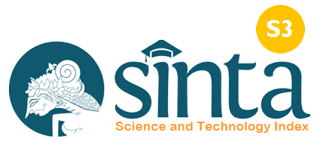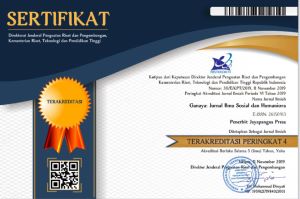Virtualisasi Pembelajaran melalui Integrasi Spatial Data Science Untuk Meningkatkan Geokapabilitas Mahasiswa PPG IPS
DOI:
https://doi.org/10.37329/cetta.v8i4.4873Keywords:
Virtualization, Spatial Data Science, GeocapabilityAbstract
The development of virtual technology encourages the innovation of learning media that is more interactive and contextual. The limitation of existing learning media in integrating spatial aspects creates an opportunity to develop media that meets learning needs. The objective of this research is to develop virtual learning media integrated with Spatial Data Science to enhance the geocapability of students in the Social Sciences Teacher Professional Program (PPG IPS). The development was carried out by utilizing Microsoft Power BI as a virtual dashboard development application capable of visualizing spatial data. The research employed a Research and Development (R&D) approach using the ADDIE development model (Analysis, Design, Development, Implementation, and Evaluation). Data were collected through three main types of instruments: validation sheets, a closed user trial questionnaire, and a user response questionnaire. Validation sheets were addressed to material, language, and media experts to obtain feasibility scores, comments, and suggestions for product improvement before the trial. The user trial questionnaire consisted of a closed multiple-choice questionnaire using a Likert scale and a user response questionnaire.The collected data were analyzed using quantitative analysis and qualitative analysis techniques. Quantitative data, which contained feasibility scores, were presented in tables, while qualitative data were presented through descriptive narratives. The research findings indicate that the developed learning media obtained an "excellent" feasibility score from both experts and users. Direct classroom implementation has not yet been carried out, so its effectiveness cannot be measured. Further research is recommended to test the media's implementation in a real learning situation to obtain a more comprehensive picture of its impact on improving the geocapability of PPG IPS students.
References
Adeoye, M. A., Wirawan, K. A. S. I., Pradnyani, M. S. S., & Septiarini, N. I. (2024). Revolutionizing Education: Unleashing the Power of the ADDIE Model for Effective Teaching and Learning. JPI (Jurnal Pendidikan Indonesia), 13(1), 202–209.
Akbar, R., Sukmawati, U. S., & Katsirin, K. (2023). Analisis Data Penelitian Kuantitatif: Pengujian Hipotesis Asosiatif Korelasi. Jurnal Pelita Nusantara, 1(3), 430–448.
Alves, S. A. A., Abreu, L. C. de, Cunha, N. das C. P., Almeida Júnior, Á. D. de, Abreu, C. I. P. O., Meirelles, A. C. A., … Bezerra, I. M. P. (2023). Description of the Scientific Method for the Preparation and Validation of Educational Technologies in Digital Format: A Methodological Study. Journal of Human Growth and Development, 33(2), 299–309.
Becker, L. T., & Gould, E. M. (2019). Microsoft Power BI: Extending Excel to Manipulate, Analyze, and Visualize Diverse Data. Serials Review, 45(3), 184–188.
Belghith, M., Ben Ammar, H., Elloumi, A., & Hachicha, W. (2024). A New Rolling Forecasting Framework Using Microsoft Power BI for Data Visualization: A Case Study in a Pharmaceutical Industry. Annales Pharmaceutiques Françaises, 82(3), 493–506.
Celik, M., Dokuz, A. S., Ecemis, A., & Erdogmus, E. (2025). Discovering Temporal, Spatial, and Contextual Anomalous Social Activities From Streaming Social Media Datasets. Engineering Science and Technology, an International Journal, 64, 102006.
Chuang, C. S., Chen, Y. W., Zeng, B. Y., Hung, C. M., Tu, Y. K., Tai, Y. C., … Tsai, C. H. (2022). Effects of Modern Technology (Exergame and Virtual Reality) Assisted Rehabilitation vs Conventional Rehabilitation in Patients With Parkinson’s Disease: A Network Meta-Analysis of Randomised Controlled Trials. Physiotherapy, 117, 35–42.
Fadilah, A. D., Nurzakiyah, K. D. R., Kanya, N. D. A., & Setiawan, U. (2023). Pengertian Media, Tujuan, Fungsi, Manfaat, dan Urgensi Media Pembelajaran. Journal of Student Research, 1(2), 01–17.
Fahrni, D. D. D., Hascher, T., & Prasse, D. (2025). Promoting Metacognitive Strategies With Educational Technology: Primary Teachers’ Beliefs and Practices. Learning in Context, 2(1–2), 100007.
Ficko, A., Sarkki, S., Gultekin, Y. S., Egli, A., & Hiedanpää, J. (2025). Reflective Thinking Meets Artificial Intelligence: Synthesizing Sustainability Transition Knowledge in Left-Behind Mountain Regions. Geography and Sustainability, 6(1), 100257.
Handayani, N. N. L., Muliastrini, N. K. E., & Suardipa, I. P. (2021). Pendidikan Profesi Guru Dalam Kaitannya Dengan Peningkatan Profesionalisme Guru. Sang Acharya: Jurnal Profesi Guru, 2(1), 1.
Hildebrand, A., Kim, M. H., & Sakas, G. (2000). C&G Special Issue Advanced and Dynamic Medical Vizualisation. Computers & Graphics, 24(5), 657–659.
Hintermann, C., Bergmeister, F. M., & Kessel, V. A. (2020). Critical Geographic Media Literacy in Geography Education: Findings From the MiDENTITY Project in Austria. Journal of Geography, 119(4), 115–126.
Ikhsan, F. A., Utaya, S., Bachri, S., Sugiarto, A., & Sejati, A. E. (2024). Paradigma Filsafat Geografi Kontemporer: Kajian Ontologi, Epistemologi, Aksiologi, dan Keterampilan Saintifik. Majalah Geografi Indonesia.
Kache, P. A., Bron, G. M., Zapata-Ramirez, S., Tsao, J. I., Bartholomay, L. C., Paskewitz, S. M., … Fernandez, M. del P. (2023). Evaluating Spatial and Temporal Patterns of Tick Exposure in the United States Using Community Science Data Submitted Through a Smartphone Application. Ticks and Tick-Borne Diseases, 14(4), 102163.
Kamnardsiri, T., Kumfu, S., Munkhetvit, P., Boripuntakul, S., & Sungkarat, S. (2024). Home-Based, Low-Intensity, Gamification-Based, Interactive Physical–Cognitive Training for Older Adults Using the ADDIE Model: Design, Development, and Evaluation of User Experience. JMIR Serious Games, 12.
Kulbayeva, A. K., Rakhmetulayeva, S. B., Bolshibayeva, A. K., & Yasar, A. U. H. (2024). Data Processing Methods for Financing Terrorism: The Role of Microsoft Power BI in Money Laundering Detection. Procedia Computer Science, 238, 528–535.
Li, X., Dong, Y., & Ai, Z. (2025). Path to Intelligent Evaluation: Utilizing Power BI for Enhanced Performance Insights. Computers and Education Open, 9, 100271.
López, M., & Couturier, S. (2023). System Design for a Near Real-Time Caribbean Sargassum Monitoring Platform in the National Laboratory for Earth Observation (LANOT), Mexico: Implementing Spatial Data Science Tools. Procedia Computer Science, 221, 292–299.
Marie, B., & AlSwaiti, F. (2024). Validity and Validation in Language Testing: Current State and Future Guidelines in Aphasiology. Aphasiology, 38(9), 1568–1588.
Maruta, A. (2023). (Invited) Brief Analysis of the Impact of Hasegawa-Nyu’s Work “Eigenvalue Communication” on Modern Optical Communication Technologies. Optik, 287, 171036.
Maulana, I., Rahma, N. A., Mahfirah, N. F., Alfarizi, W., & Darlis, A. (2023). Meningkatkan Profesional Guru Dengan Program Pendidikan Profesi Guru (PPG). Journal on Education, 5(2), 2158–2167.
Meadows, M. E. (2020). Geography Education for Sustainable Development. Geography and Sustainability, 1(1), 88–92.
Melis, R., Malavasi, M., Bazzichetto, M., Caria, M. C., Rivieccio, G., Denaro, A., … Bagella, S. (2025). Unravelling Bias: A Sardinian Perspective on Taxonomic, Spatial, and Temporal Biases in Vascular Plant Biodiversity Data From GBIF. Ecological Informatics, 90, 103289.
Nickell, E. B., Schwebke, J., & Goldwater, P. (2023). An Introductory Audit Data Analytics Case Study: Using Microsoft Power BI and Benford’s Law to Detect Accounting Irregularities. Journal of Accounting Education, 64, 100855.
Nika, S. S., & Rahayu, N. (2024). Pengembangan Profesionalitas Guru Melalui Pendidikan Profesi Guru (PPG) Dalam Peningkatan Mutu Pendidikan Indonesia. Nizhamiyah, 14(1), 81–98.
Osborne, Z. M., van de Gevel, S. L., Eck, M. A., & Sugg, M. (2020). An Assessment of Geospatial Technology Integration in K–12 Education. Journal of Geography, 119(1), 12–21.
Pramesti, A. A., Sitompul, R. P., Sopiya, N., & Fitroh. (2022). Systematic Literature Review: Pemanfaatan Virtual Reality (VR) Sebagai Alternatif Media Pembelajaran. Jurnal Pendidikan Teknologi dan Kejuruan, 19(2), 105–117.
Purwanto, Hamdan, A., Putra, A. K., Aripriharta, Tan, I., & Farihah, S. N. (2024). Geo-Virtual Reality (GVR): The Creative Materials to Construct Spatial Thinking Skills Using Virtual Learning Based Metaverse Technology. Thinking Skills and Creativity, 54, 101664.
Purwanto, Utaya, S., Handoyo, B., & Bachri, S. (2020). Transformation of Geospatial Technology Knowledge in Pre-Service and Experienced Geography Teachers as Pedagogical Tools in the Technological-Pedagogical-Content Knowledge Framework. International Journal of Learning, Teaching and Educational Research, 19(9), 58–76.
Schoder, J., & Bücker, H. M. (2025). Exploring Data Science Workflows: A Practice-Oriented Approach to Teaching Processing of Massive Datasets. Journal of Parallel and Distributed Computing, 200, 105043.
Solari, O. M., Demirci, A., & van der Schee, J. (2015). Geospatial Technologies and Geography Education in a Changing World: Geospatial Practices and Lessons Learned. Geospatial Technologies and Geography Education in a Changing World: Geospatial Practices and Lessons Learned, 1–221.
Tsaaqib, A., Buchori, A., & Endahwuri, D. (2022). Efektivitas Penggunaan Media Pembelajaran Virtual Reality (VR) Pada Materi Trigonometri Terhadap Motivasi dan Hasil Belajar Matematika Siswa SMA. JIPMat, 7(1), 11–19.
Uggla, G., & Horemuz, M. (2018). Geographic Capabilities and Limitations of Industry Foundation Classes. Automation in Construction, 96, 554–566.
Wang, T., Zhao, X., & Li, X. (2025). Geographical Influences, Media Attention and Enterprise Digital Transformation. Technological Forecasting and Social Change, 210, 123853.
Young, S. G., Datta, J., Kar, B., Huang, X., Williamson, M. D., Tullis, J. A., & Cothren, J. (2021). Challenges and Limitations of Geospatial Data and Analyses in the Context of COVID-19. 137–167.
Yu, S. J., Hsueh, Y. L., Sun, J. C. Y., & Liu, H. Z. (2021). Developing an Intelligent Virtual Reality Interactive System Based on the ADDIE Model for Learning Pour-Over Coffee Brewing. Computers and Education: Artificial Intelligence, 2, 100030.
Zhang, M., Luo, X., & Huang, N. (2024). Integrating Neighborhood Geographic Distribution and Social Structure Influence for Social Media User Geolocation. CMES – Computer Modeling in Engineering and Sciences, 140(3), 2513–2532.
Downloads
Published
How to Cite
Issue
Section
License
Copyright (c) 2025 Purwanto Purwanto, Didik Sukriono, Reza Hudiyanto, Erisa Elvada, Alfariz Maulana Yusuf, Mayang Eka Israni

This work is licensed under a Creative Commons Attribution-ShareAlike 4.0 International License.
An author who publishes in the Cetta : Jurnal Ilmu Pendidikan agrees to the following terms:
- Author retains the copyright and grants the journal the right of first publication of the work simultaneously licensed under the Creative Commons Attribution-ShareAlike 4.0 License that allows others to share the work with an acknowledgement of the work's authorship and initial publication in this journal
- Author is able to enter into separate, additional contractual arrangements for the non-exclusive distribution of the journal's published version of the work (e.g., post it to an institutional repository or publish it in a book) with the acknowledgement of its initial publication in this journal.
- Author is permitted and encouraged to post his/her work online (e.g., in institutional repositories or on their website) prior to and during the submission process, as it can lead to productive exchanges, as well as earlier and greater citation of the published work (See The Effect of Open Access).
Read more about the Creative Commons Attribution-ShareAlike 4.0 Licence here: https://creativecommons.org/licenses/by-sa/4.0/.





